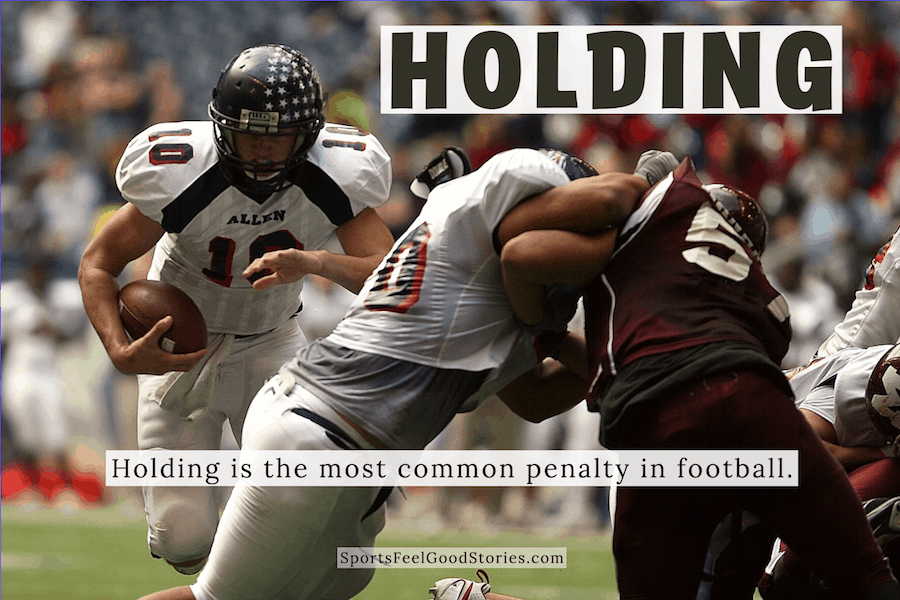The most common penalty in football – the holding penalty – is one that fans of the game should know inside and out. We’ve taken a crack at defining holding, distinguishing between offensive and defensive holding, and some of the other intricacies. Read on.
What does holding mean in football?
Holding is an illegal off-the-ball foul of attempting to block an opponent. Holding is penalized, with the penalized team losing five or 10 yards from the line of scrimmage. If it is offensive holding, then the penalty is 10 yards. However, defensive holding is penalized five yards and an automatic first down. If the holding is called within 20 yards of the end zone, the infringement will be penalized by deducting half the distance to the goal.
Key Takeaways
- Importantly, holding is the most common penalty in football that can occur on anyone other than the ball carrier.
- Offensive holding penalties are penalized by 10 yards. Likewise, defensive holding penalties are penalized but for five yards and an automatic first down.
- In 2019, NFL officials called holding 724 times throughout the season. Compare that to the second most common penalty, false start, which got called 547 times. ESPN reported that offensive holding accounts for nearly 21% of all penalties in recent years.
- There is a five-yard area from the line of scrimmage that allows defensive players to use their hands without getting called for holding.

What is offensive holding?
As defined by NFL Video Rulebook, offensive holding is described as “Use his hands or arms to materially restrict an opponent or alter the defender’s path or angle of pursuit. It is a foul regardless of whether the blocker’s hands are inside or outside the frame of the defender’s body.” The three criteria to watch for holding are: grabbing or tackling an opponent, hooking or twisting an opponent, pulling an opponent to the ground.
What is defensive holding?
Defensive holding is the same as offensive holding when done by a player on defense. It can be committed by any of the 11 players on the defensive team. Defensive holding occurs whenever a defensive player interferes with a player who is not carrying the ball. Defensive holding occurs more with one-on-one matchups between wide receivers and cornerbacks.
When does holding happen?
Holding is the most common penalty in football. Holding can occur during every play, whether during a passing play, hand-off, field goal attempt, punt, or kickoff. While linemen get called on holding the most, it is still commonly called on wide receivers and defensive backs. In 2019, Denver Broncos offensive tackle Garett Boles led the NFL with ten offensive holding penalties. This included four in his Week Two matchup against the Chicago Bears.
What is the penalty for holding?
Offensive holding is penalized with the offensive team moving back 10 yards from the line of scrimmage. For example, if it is 1 & 10 from the offensive team’s own 25-yard line, the holding penalty would make it 1 & 20 from the offensive team’s own 15-yard line. If the offensive team is inside their 20-yard line and commits a holding penalty, the ball would be moved back half the distance to the goal.
Defensive holding is penalized, with the offensive team gaining five yards and an automatic first down. For example, let’s assume the play is 2 & 6 from the offensive team’s own 30, and the defense commits a holding penalty. Consequently, the offensive team would get the ball at their own 35 and 1st & 10. If the defensive team commits holding while the offensive team has the ball inside the defensive team’s 20, the ball would be moved half the distance to the goal.
Can you decline a holding penalty?
Just like any other penalty, you can decline a holding penalty. Additionally, it is essential to note that holding penalties happen as the play develops. So, the referees let the play happen before blowing the play dead. In cases of defensive holding, it is essentially a ‘free play’ for the offensive team to try and get a big play.
Coaches may want to decline a holding penalty only if the outcome of the play is more beneficial to their team than if they accepted the penalty. For example, assume a defensive holding penalty is called, and the offensive team scores a touchdown on the same play. Consequently, the coach would almost always decline the penalty. If the offensive team were to pick up a gain of three, the coach would most likely accept the penalty. As a result, his team would gain more yardage and another set of downs with the penalty.

Overtime
You’re on our Holding Penalty in Football – Offensive and Defensive page.
You might like:
Who qualifies as an eligible receiver?
A Drive Definition and Famous Scoring Drives
Football Receivers: Role, Types, FAQs
